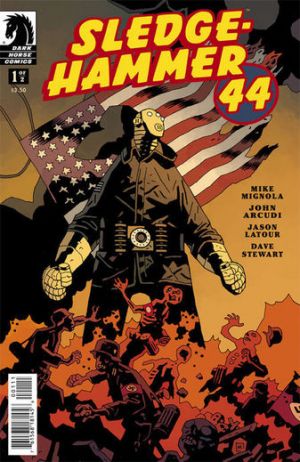Comics /
Comic Reviews /
More Comics
Sledgehammer 44 #1 Review
By Zak Edwards
March 13, 2013 - 16:27
I have a bit of a confession to make: I’m not really a Hellboy fan. I read the first trade dutifully, years ago, and found it, well, boring. The story didn’t stand out and, while Alan Moore’s introduction compared the art to red wine, I didn’t really think too much of it. So, when I was presented with the chance to review Sledgehammer 44, a Mignola book that seems at once inside and outside his growing universe, I thought my perspective could bring something different. After all, it seems like most critics either love everything Mignola does or just don't review it. Well, prepare for something fairly in between!
 |
In between because this book is interesting and everything, but considering I just re-watched Inglorious Basterds yesterday, Mignola’s take on a fictional World War 2 just seems lacking a certain je ne sais quoi. The retro-future explorations of WWII, deeply indebted to the years of rumours about Nazi technological experiments, aren’t really anything new. Here, they take the place of a bomb containing a robot/cyborg/metal-suited man, playing off the anxiety of ‘the bomb’ that still graces today’s headlines. The book is fairly humdrum, just as that first trade of Hellboy is slapping some red wine art onto a beaten to death concept taken straight from the pages of Milton and funneled through the easiest dichotomy left for us: Nazis. And maybe I am just bored of the easy way out of villains in books, but just having Nazis is perfectly uninteresting: a fascination with the extreme violence and horror that we humans are capable of. And before someone decides to attack me with the threat of “Lest We Forget,” I would argue that Sledgehammer 44 is hardly part of an ongoing memorial to WWII and certainly distant from any call to engage with the horrors of yesterday to prevent the genocides of tomorrow. The Nazi figure just doesn’t do it for me and, really, this book doesn’t seem to be doing anything interesting with the setting other than laziness in villainy. Now, if this was set in WWI, I think that could have made for a much more interesting story since the easy villain isn’t as easy anymore.
All that being said, this book is fairly entertaining. The question of what exactly is in that suit certainly gives readers something to hold on to. And Mignola’s men on the ground, the very real looking soldiers are quite distinct and, something I very much appreciate, quite human. They stand astounded, carry the robot man around in a wheelbarrow, and somewhat haphazardly try to stick to an effective chain of command. The newcomers who are blatantly Nazis, are resolved as such for a cliffhanger, but I find myself not really interested in what’s going to happen. Probably not the best result for a new book.
But as for new, I would like artist Jason Latour to draw more books, please. His cartoonish style, and I mean this in the Seth and classic New Yorker magazine sense of the term, plays with nostalgia in very productive ways. There is a real sense of past through his art while his action scene constructions slowly build to moments of legitimate aw. Unlike Seth, who’s work is exceptionally static, Latour has an eye for movement from page to page, panel to panel, combining a more mainstream sensibility with a style embedded in the past. The artwork far outstrips the writing, but that makes me head straight to the internet to find more Latour, not more Mignola.
Grade: 6/10 Fairly easy and predictable writing blended with wonderful art. Mignola fans will love this, newcomers will probably be left uninterested.
Last Updated: January 17, 2025 - 08:20
